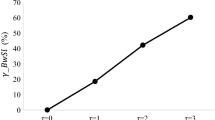Abstract
This work infers on the conjoint adoption of collaboration practices and replenishment rules as bullwhip dampening techniques in a limited capacity production network. Continuous time differential equation methodology is adopted to model three supply chain configurations. Results show that theconditio sine qua non for long-term capacity strategy is the management and control of information asynchronies, provided by collaboration practices and ad-hoc decision policies. Furthermore the study reveals the phenomenon of bullwhip rough dampening.
Access this chapter
Tax calculation will be finalised at checkout
Purchases are for personal use only
Preview
Unable to display preview. Download preview PDF.
Similar content being viewed by others
References
Disney, S.M., Lambrecht, M.R.: On Replenishment Rules, Forecasting, and the Bullwhip Effect in Supply Chains. Foundations and Trends in Technology, Information and Operations Management 2, 1–80 (2008)
Holweg, M., Disney, S.M.: The Evolving Frontiers of the Bullwhip Problem. In: EurOMA: Operations and Global Competitiveness, Budapest, pp. 777–716 (2005)
Mitchell, T.: Competitive illusion as a cause of business cycles. Quarterly Journal of Economics 38, 631–652 (1923)
Forrester, J.: Industrial dynamics: a major break though for decision-makers. Harvard Business Review 36, 37–66 (1958)
Lee, H.L., Padmanabhan, V., Whang, S.: Information distortion in a supply chain: the bullwhip effect. Management Science 43, 546–558 (1997)
Lee, H.L., Padmanabhan, V., Whang, S.: The Bullwhip effect in supply chains. Sloan Management Review 38, 93–102 (1997)
Towill, D.R.: Dynamic analysis of an inventory and order based production control system. International Journal of Production Research 20, 369–383 (1982)
Houlihan, J.B.: International supply chain management. International Journal of Physical Distribution and Materials Management 17, 51–66 (1987)
Sterman, J.D.: Modelling managerial behaviour: misperceptions of feedback in a dynamic decision-making experiment. Management Science 35, 321–339 (1989)
Burbidge, J.L.: Period batch control (PBC) with GT – the way forward from MRP. In: BPICS Annual Conference. Birmingham (1991)
Wikner, J., Towill, D.R., Naim, M.M.: Smoothing supply chain dynamics. International Journal of Production Economics 22, 231–248 (1991)
Chen, F., Drezner, Z., Ryan, J.K., Simchi-Levi, D.: Quantifying the bullwhip effect in a simple Supply Chain: the impact of forecasting, lead-times and information. Management Science 46, 436–443 (2000)
Dejonckheere, J., Disney, S.M., Lambrecht, M.R., Towill, D.R.: The impact of information enrichment on the bullwhip effect in Supply Chains: A control engineering perspective. European Journal of Operational Research 153, 727–750 (2004)
Warburton, R.D.H.: An Analytical Investigation of the Bullwhip Effect. Production and Operations Management 13, 150–160 (2004)
Grubbström, R.W., Wang, Z.: A stochastic model of multi-level/multi-stage capacity-constrained production–inventory systems. International Journal of Production Economics 81-82, 483–494 (2003)
Riddalls, C.E., Bennett, S., Tipi, N.S.: Modelling the dynamics of supply chains. International Journal of Systems Science 31, 969–976 (2000)
Disney, S.M., Naim, M.M., Potter, A.T.: Assessing the impact of e-business on supply chain dynamics. The International Journal of Production Economics 89, 109–118 (2004)
Kleijnen, J.P.C., Smits, M.T.: Performance metrics in supply chain management. The Journal of Operational Research Society 54, 507–514 (2003)
Geary, S., Disney, S.M., Towill, D.R.: On bullwhip in supply chains - historical review, present practice and expected future impact. International Journal of Production Economics 101, 2–18 (2006)
Towill, D.R., Zhou, L., Disney, S.M.: Reducing the bullwhip effect: Looking through the appropriate lens. International Journal of Production Economics 108, 444–453 (2007)
van Ackere, A., Larsen, E.R., Morecroft, J.D.W.: Systems thinking and business process redesign: An application to the beer game. European Management Journal 11, 412–423 (1993)
Disney, S.M., Towill, D.R.: On the bullwhip and inventory variance produced by an ordering policy. Omega, the International Journal of Management Science 31, 157–167 (2003)
Cachon, G., Fisher, M.: Campbell Soup’s continuous replenishment program: Evaluation and enhanced inventory decision rules. Productions and Operations Management 6, 266–276 (1997)
Holmstrom, J., Framling, K., Kaipia, R., Saranen, J.: Collaborative planning forecasting and replenishment: new solutions needed for mass collaboration. Supply Chain Management: An International Journal 7, 136–145 (2002)
Lalwani, C.S., Disney, S.M., Towill, D.R.: Controllable, Observable and controllable state space representations of a generalized Order-Up-To policy. International Journal of Production Economics 101, 173–184 (2006)
John, S., Naim, M.M., Towill, D.R.: Dynamic analysis of a WIP compensated decision support system. International Journal of Management Systems Design 1, 283–297 (1994)
Simon, H.A.: On the application of servomechanism theory to the study of production control. Econometrica 20, 247–268 (1952)
Axsäter, S.: Control theory concepts in production and inventory control. International Journal of Systems Science 16, 161–169 (1985)
Disney, S.M., Towill, D.R.: The effect of vendor managed inventory (VMI) dynamics on the Bullwhip Effect in supply chains. International Journal of Production Economics 85, 199–215 (2003)
Cannella, S., Ciancimino, E.: The APIOBPCS Deziel and Eilon parameter configuration in supply chain under progressive information sharing strategies. In: Winter Simulation Conference, Miami (2008)
Evans, G.N., Naim, M.M.: The dynamics of capacity constrained supply chains. In: International System Dynamics Conference, Stirling, Scotland, pp. 28–35 (1994)
Simchi-Levi, D., Zhao, Y.: The value of information sharing in a two-stage supply chain with production capacity constraints. Naval Research Logistics 50, 888–916 (2003)
Disney, S.M., Towill, D.R.: A methodology for benchmarking replenishment-induced bullwhip. Supply Chain Management: An International Journal 11, 160–168 (2006)
Deziel, D.P., Eilon, S.: A linear production: inventory control rule. The Production Engineer 43, 93–104 (1967)
Author information
Authors and Affiliations
Editor information
Editors and Affiliations
Rights and permissions
Copyright information
© 2009 Springer-Verlag Berlin Heidelberg
About this paper
Cite this paper
Ciancimino, E., Cannella, S. (2009). Modelling the Bullwhip Effect Dampening Practices in a Limited Capacity Production Network. In: Yang, J., Ginige, A., Mayr, H.C., Kutsche, RD. (eds) Information Systems: Modeling, Development, and Integration. UNISCON 2009. Lecture Notes in Business Information Processing, vol 20. Springer, Berlin, Heidelberg. https://doi.org/10.1007/978-3-642-01112-2_48
Download citation
DOI: https://doi.org/10.1007/978-3-642-01112-2_48
Publisher Name: Springer, Berlin, Heidelberg
Print ISBN: 978-3-642-01111-5
Online ISBN: 978-3-642-01112-2
eBook Packages: Computer ScienceComputer Science (R0)




